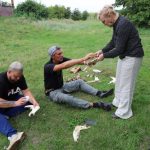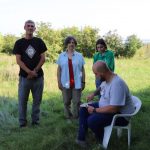Experimental-traceological expedition in Bolgar
From 13 to 26 August 2024, an experimental-traceological expedition organized jointly by the Institute for the History of Material Culture of the Russian Academy of Sciences (St. Petersburg) and the Institute of Archaeology named after A.Kh. Khalikov of the Tatarstan Academy of Sciences (Kazan) was held in Bolgar. The first joint experimental-traceological expedition started its work in Bolgar in 2023 simultaneously with the X International Archaeological School.
The 2024 expedition continues the traditions of field experimental-traceological research, initiated by the famous scientist Sergey Aristarkhovich Semyonov, the founder of a special direction in archaeology – the study of prehistoric technology. This direction in 1957 revolutionized primeval archaeology by combining the study of traces of the use of tools with experimental studies of the flakes of their manufacture and use. After the publication of the English translation of S.A. Semyonov’s book “Prehistoric Technology” in 1964. This technology has become widely used in research by archaeologists around the world.
The 2024 expedition included researchers from St. Petersburg, Kazan, Yekaterinburg, Samara, and Guangzhou (China). The heads of the expedition are N.N. Skakun (IHMC RAS) and M.Sh. Galimova (IA TAS). The participants of the expedition made replicas of ancient tools, which were used in different works. Traces left on the working parts of the standard tools were studied and photographed using a microscope. The experiments were related to receiving the standards, needed to characterize certain categories of poorly studied implements. They were carried out following the procedures, developed during the LBIA/IHMC long-term experimental expeditions. The studies included: theoretical preparation, setting tasks, ensuring the approximation of experiments to ancient conditions, performing the same operation from beginning to end to establish statistical regularities in the appearance of diagnostic features for a particular function of the tool.
The main direction of work in 2024 is to clarify the patterns of formation of traces of use characteristic of poorly studied tools for grinding various types of vegetation. Another direction was to find out the ways of making and using specific implements from the jaws of horses and cows, which are often found in the Eneolithic-Bronze Age sites in the vast territory of Eurasia. After studying the data of the scientific literature, it became clear that the issues of primary processing of these types of blanks of bone tools were poorly covered.
The first stage of experimental work was aimed at testing the hypotheses on the technology of processing of specific bone tools stated earlier. In the course of experiments, some methods of preliminary processing of bone, necessary for its subsequent creation of different implements, known from archaeological finds, were used. As a result of these works, new data on functional diagnostics of tools for grinding different types of plants were got. Experiments on making tools from horse and cow jaws will be continued. The data received by the expedition are a reliable source for further experimental-traceological research.





